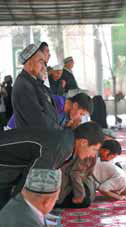Ancient Beauty
Updated: 2012-06-07 13:08
By Shao Wei (China Daily)
|
||||||||
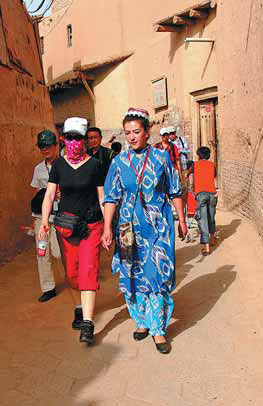 |
|
A Uygur guide leads a group of tourists on a walk around the alleys of old Kashgar. Huang Zhe / for China Daily |
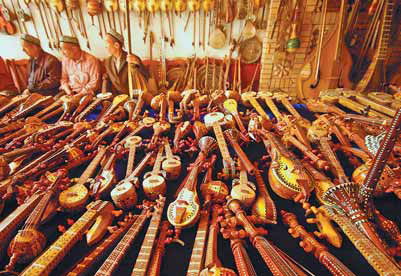 |
|
Uygur musical instruments are hot commodities at local markets. Yuan Peide / for China Daily |
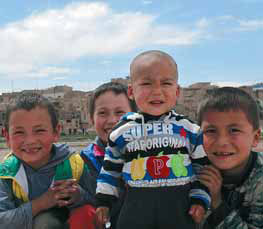 |
|
Young Uygurs greet visitors with big smiles. Shao Wei / China Daily |
Legend has it that a Fragrant Concubine existed during the Qing Dynasty in Kashgar, who exuded an enchanting aroma without using perfume. Shao Wei explores this oasis of civilization and discovers that the city oozes more than just legendary charms.
|
|
|
Id Kah Mosque. Liu Shuxian / for China Daily |
Many visitors to Kashgar, a city replete with historic and exotic characteristics along the ancient Silk Road, may feel like they are in North Africa or the Middle East. Uygur women wear veils or headscarves; men put on woven doppa, or white, knitted caps; bustling and noisy bazaars are filled with the aroma of roasted mutton and cumin. The city, especially its old town block, is filled with cluttered and amazingly clean streets, where motorcycles and mini-buses negotiate their way, along with donkey carts.
I was advised to pick up a few Uygur phrases before visiting, which I did, as most of the city's population who are Uygurs cannot understand Mandarin.
But language is overcome by the hospitality of the city, which is as warm as its summer. According to Uygur tradition, if the door and the curtain of a house are both open, tourists can freely visit to enjoy a cup of milk tea and snacks offered by the hostess.
Cycling is the best way to see the city during summer, which is dry and hot with the highest temperature hovering around 40 C.
Visitors could also save precious time under the scorching sun when cycling on the complicated, narrow and winding alleys.
I stay at the Old Town Youth Hostel in downtown Kashgar, which offers bicycle rental service, at a cost of 20 yuan ($3) a day and the hostel's guests are exempted from placing a deposit.
The hostel also provides visitors with a hand-drawn, user-friendly map, which clearly marks out the major tourist destinations, hotels, bus stations and ATMs in the city.
My first stop is Id Kah Mosque, one of the largest of its kind in the country.
Every Friday, 6,000 to 7,000 Uygurs converge at the mosque to perform the obligatory prayers, five times daily. During important festivals, the number could increase to 10,000. It is common to see crowds overflowing to the square outside, answering the call from the minarets all over the city.
The old town has a very distinct characteristic - the color yellow, as the houses are made of mudstone and wood. Some old houses look shabby externally, but amazingly clean and beautifully decorated inside.
Newly built houses and those under construction are also painted with yellow mud on the external wall to keep to the original feature of the old town.
But there are some houses that have adopted what Musa, a 21-year-old Uygur man, calls "a new and modern look", since the government launched a reconstruction program in 2010.
The other part of the old town is Gaotai, also called the Hathpace Residences.
Unfortunately, the Hathpace, built on the loess cliff in the southeast section of the old town, is now undergoing reconstruction. It is known as "castles in the air" for its highly distinctive architectural forms.
"The dilapidated century-old houses put visitors and residents in danger. They are now undergoing reconstruction, to strengthen the structures while maintaining their original architectural characteristics," Musa explains.
It was not easy moving the people in the area as most families have lived there for generations, Musa says.
Though the area is not open to tourists this year, Musa showed me an entry into the Hathpace, which is on the northern bank of East Lake.
"Make sure you just have a brief look around, don't venture too far," he adds.
Unlike the quiet, leisurely atmosphere in the Hathpace, a few streets away is the East Lake Bazaar which is a hubbub of noises, where bargaining is the order of the day.
The big market offers dried fruits and nuts, musical instruments, wooden or brass products, clothing and textiles, and various ornaments.
Kashgar shares an 888-km border with Afghanistan, Tajikistan and Pakistan, which explains why its bazaars are full of businessmen and commodities from these neighboring countries. Locals and visitors are seen strolling from one street to another, seeking food, drinks and exotic souvenirs.
Another upside about visiting Kashgar during summer is the long day and short night. Following the Xinjiang timezone, which is two hours behind Beijing, the city bathes in daylight right up to 10 pm.
My last stop is the Tomb of the Fragrant Concubine, one of Emperor Qianlong's imperial concubines during the Qing Dynasty (1644-1911).
Legend has it that Fragrant Concubine exuded an enchanting fragrance without using perfume. Uygurs believe her fragrance came from her habit of bathing with shazao (sand date) flowers.
I didn't try bathing with the local blossoms but enjoyed it in a cup, sipping the flower tea sold at the entrance of the tomb. It was refreshing and fragrant.
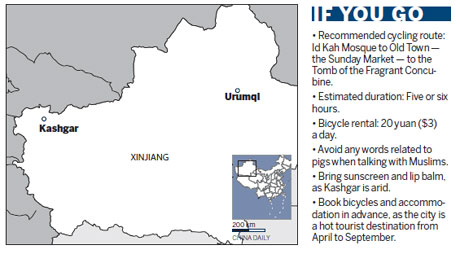

 'Taken 2' grabs movie box office crown
'Taken 2' grabs movie box office crown
 Rihanna's 'Diamonds' tops UK pop chart
Rihanna's 'Diamonds' tops UK pop chart
 Fans get look at vintage Rolling Stones
Fans get look at vintage Rolling Stones
 Celebrities attend Power of Women event
Celebrities attend Power of Women event
 Ang Lee breaks 'every rule' to make unlikely new Life of Pi film
Ang Lee breaks 'every rule' to make unlikely new Life of Pi film
 Rihanna almost thrown out of nightclub
Rihanna almost thrown out of nightclub
 'Dark Knight' wins weekend box office
'Dark Knight' wins weekend box office
 'Total Recall' stars gather in Beverly Hills
'Total Recall' stars gather in Beverly Hills
Most Viewed
Editor's Picks

|

|

|

|

|

|
Today's Top News
Health new priority for quake zone
Xi meets US top military officer
Japan's boats driven out of Diaoyu
China mulls online shopping legislation
Bird flu death toll rises to 22
Putin appoints new ambassador to China
Japanese ships blocked from Diaoyu Islands
Inspired by Guan, more Chinese pick up golf
US Weekly

|

|
